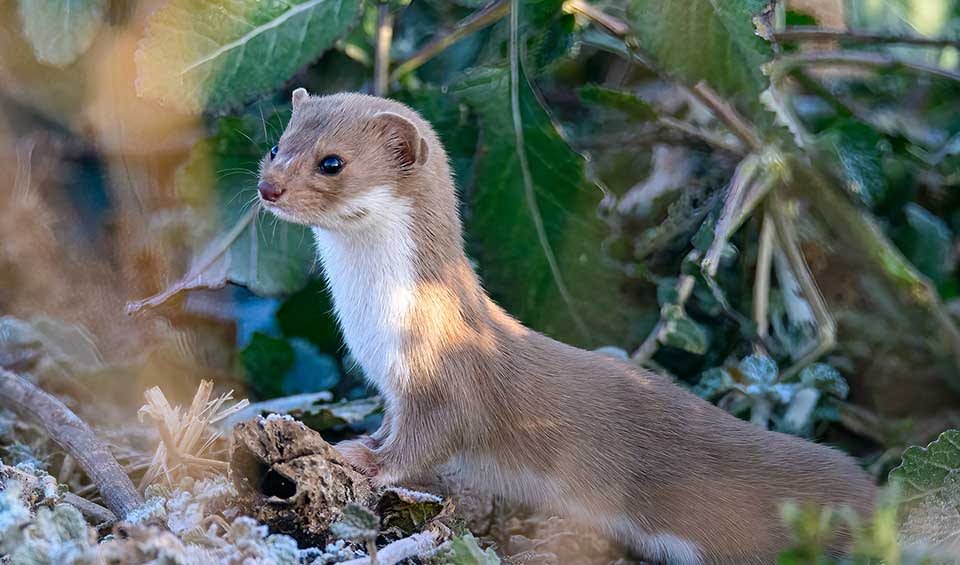The least weasel is a fascinating and agile predator renowned for its slender, tubular body, short limbs, and distinctive coat variations. During the winter months, the least weasel dons a coat of pure white fur, providing excellent camouflage against snowy landscapes. In contrast, the summer season brings a transformation, with the fur adopting a rusty chocolate brown hue on the back while retaining its white underbelly.
One notable feature of the least weasel is its non-retractable claws, which adorn each of its toes and serve as essential tools for capturing prey and navigating its environment. These sharp claws provide traction on various surfaces, enabling the least weasel to maneuver swiftly and efficiently as it hunts for food.
Despite its diminutive size, the least weasel possesses remarkable hunting prowess, often targeting prey species that are larger than itself. With agile movements and keen senses, the least weasel stealthily stalks its prey, relying on its speed and agility to capture the elusive quarry. Small rodents such as mice and voles comprise the primary diet of the least weasel, reflecting its specialization as a rodent hunter. However, the least weasel’s diet is not limited to rodents alone, as it also preys upon rabbits, birds, frogs, and other small vertebrates found within its habitat.
A unique aspect of the least weasel’s hunting behavior is its propensity to store excess food for future consumption. After capturing prey, the least weasel may consume only a few grams of meat before stashing the remainder in its burrow or cache site. This behavior ensures a constant supply of food during times of scarcity, providing the least weasel with vital sustenance to survive harsh environmental conditions and periods of limited prey availability.
Distribution
 Afghanistan
Afghanistan Albania
Albania Algeria
Algeria Andorra
Andorra Armenia
Armenia Austria
Austria Azerbaijan
Azerbaijan Belarus
Belarus Belgium
Belgium Bosnia And Herz.
Bosnia And Herz. Bulgaria
Bulgaria Canada
Canada China
China Croatia
Croatia Czechia
Czechia Denmark
Denmark Estonia
Estonia Finland
Finland France
France Georgia
Georgia Germany
Germany Greece
Greece Hungary
Hungary Iran
Iran Italy
Italy Japan
Japan Kazakhstan
Kazakhstan Korea
Korea Kyrgyzstan
Kyrgyzstan Latvia
Latvia Lebanon
Lebanon Liechtenstein
Liechtenstein Lithuania
Lithuania Luxembourg
Luxembourg Malta
Malta Moldova
Moldova Monaco
Monaco Mongolia
Mongolia Montenegro
Montenegro Morocco
Morocco Netherlands
Netherlands New Zealand
New Zealand North Korea
North Korea North Macedonia
North Macedonia Norway
Norway Poland
Poland Portugal
Portugal Romania
Romania Russia
Russia San Marino
San Marino Sao Tome And Principe
Sao Tome And Principe Serbia
Serbia Slovakia
Slovakia Slovenia
Slovenia Spain
Spain Sweden
Sweden Switzerland
Switzerland Syria
Syria Taiwan
Taiwan Tajikistan
Tajikistan Turkey
Turkey Turkmenistan
Turkmenistan Ukraine
Ukraine United Kingdom
United Kingdom United States
United States Uzbekistan
UzbekistanAnything we've missed?
Help us improve this page by suggesting edits. Glory never dies!
Suggest an editGet to know me
Terrestrial / Aquatic
Altricial / Precocial
Polygamous / Monogamous
Dimorphic (size) / Monomorphic
Active: Diurnal / Nocturnal
Social behavior: Solitary / Pack / Herd
Diet: Carnivore / Herbivore / Omnivore / Piscivorous / Insectivore
Migratory: Yes / No
Domesticated: Yes / No
Dangerous: Yes / No





